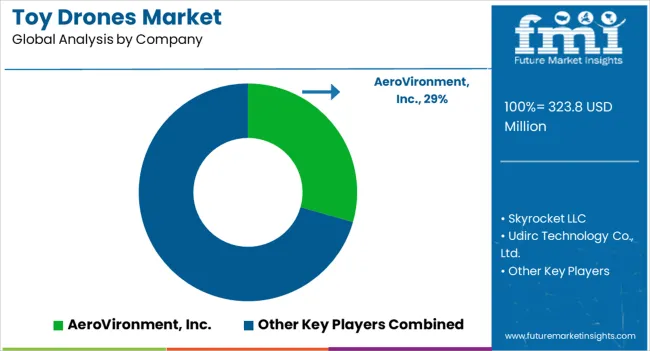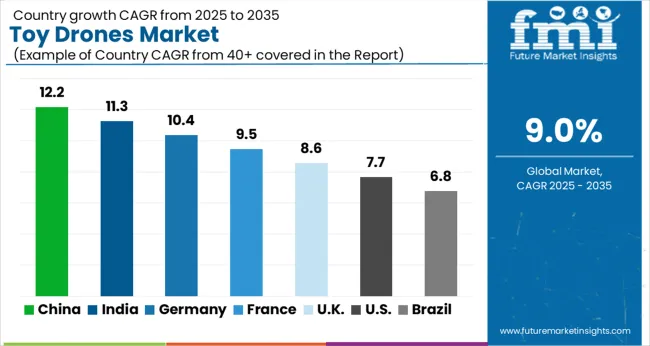The Toy Drones Market is estimated to be valued at USD 323.8 million in 2025 and is projected to reach USD 766.5 million by 2035, registering a compound annual growth rate (CAGR) of 9.0% over the forecast period.

| Metric | Value |
|---|---|
| Toy Drones Market Estimated Value in (2025 E) | USD 323.8 million |
| Toy Drones Market Forecast Value in (2035 F) | USD 766.5 million |
| Forecast CAGR (2025 to 2035) | 9.0% |
The toy drones market is expanding rapidly due to increasing consumer interest in aerial play, affordable drone technology, and the integration of user friendly controls and safety features. Advancements in lightweight materials, battery efficiency, and wireless connectivity have made drones more accessible to a broader audience, including younger users and hobbyists.
Rising popularity of drone based recreational activities and growing acceptance as educational tools for STEM learning are fueling adoption. The introduction of features such as obstacle avoidance, stabilized cameras, and app based control systems has enhanced the overall user experience.
Regulatory clarity in several regions concerning permissible toy drone usage has also supported market penetration. The outlook remains favorable as manufacturers focus on affordable customization, improved safety mechanisms, and integration with digital platforms to expand consumer engagement and market share.
The fixed wing type product segment is projected to represent 54.20% of the total market revenue by 2025, making it the leading category. This dominance is attributed to its longer flight duration, higher speed, and greater coverage area compared to other toy drone designs.
Its aerodynamic efficiency enables sustained flights, which appeals to consumers seeking extended recreational experiences. Additionally, the fixed wing type offers structural simplicity and durability, making it suitable for outdoor activities and varied terrains.
The ease of assembly and cost effectiveness have further reinforced its adoption. As toy drones evolve with improved battery performance and lightweight composites, the fixed wing type continues to hold its leadership position in the product category.
The videography and photography application segment is expected to account for 48.60% of total market revenue by 2025, positioning it as the most significant application. This is driven by the rising popularity of aerial imagery and the desire among consumers to capture unique perspectives during recreational activities.
Integration of high definition cameras, real time streaming, and user friendly stabilization technologies has enhanced the visual output of toy drones, making them more attractive to hobbyists and casual users. The affordability of drones equipped with imaging capabilities has broadened accessibility, particularly for younger demographics and entry level enthusiasts.
The cultural trend of sharing digital content across social media platforms has further accelerated adoption. Consequently, videography and photography remain the primary application driving growth in the toy drones market.
Constant Technological Advancement to Let Toy Drones Stay Ahead of the Curve
Amongst all the recent technological development, toy drones are largely witnessing innovations and advancements in the current state. With the growing adoption of autonomous flight technology, some toy drones also fly without any user guiding the path.
System-failure responses, dynamic routing, and handoffs between human and machine controllers will elevate the demand for toy drones. Consequently, toy drones are paving their way in the military landscape as military-developed technology.
In the US military reconnaissance and strike missions, drones have become a crucial component in the recent past. With the help of this technological adoption, the US Army has successfully completed some major missions. At the same time, the agriculture sector is experiencing a huge demand for toy drones for growth and development.
By enabling more efficient precision crop spraying and efficient land surveying, toy drones are helping the farmers to increase productivity and lower costs. Owing to the growing usage of toy drones in several sectors, government investments are continuously increasing.
Government is investing a huge amount in the commercial sector to develop cyberspace. In context with the aforementioned factors, the toy drones market will continue to soar over the forecast period.
Toy Drones Market to Weigh Down with Government Regulation
The toy drones technology booming at an unprecedented rate over the past few years. In such a rapidly and drastically evolving and changing ecosystem, government authorities of some countries are struggling to match the rate at which drones are reaching homes. The governments are facing difficulties in establishing drone laws, in order to match the changing landscape of drones.
For instance, Government of India had banned the use of civil drones in 2014. However, with growing adoption of the technology in other countries, it pushed the government to understand the prospects of growth with it. Therefore, in 2020, the Indian Government made changes in the policies regarding the use of drones. Such government regulations are likely to impact the growth of the toy drones market.

Examples of some of the market participants in the global toy drones market identified across the value chain include

North America to hold a major share in the toy drones market. This trend is likely to continue over the forecast period owing to encouraging government initiatives with the development in drone technology coupled with increasing demand from businesses for drone-acquired data.
On the other hand, APAC will rise at a significant pace as China and Japan are experiencing adoption of advanced technologies and automation to counter rising labour costs. Increasing manufacturing of lightweight drones and the availability of low-cost drones in countries such as China are catapulting the toy drone market growth.
Sales of toy drones are stagnant in Europe due to the government regulations. Companies in the toy drones market are exploring new paths to transform by leveraging benefits offered by UAVs.
The toy drones market report is a compilation of first-hand information, qualitative and quantitative assessment by industry analysts, and inputs from industry experts and industry participants across the value chain. The report provides in-depth analysis of parent market trends, macro-economic indicators, and governing factors, along with market attractiveness as per segment.
The market report also maps the qualitative impact of various market factors on market segments and geographies.
The global toy drones market is estimated to be valued at USD 323.8 million in 2025.
The market size for the toy drones market is projected to reach USD 766.5 million by 2035.
The toy drones market is expected to grow at a 9.0% CAGR between 2025 and 2035.
The key product types in toy drones market are fixed wing type, rotor type and flapping wing type.
In terms of application, videography & photography segment to command 48.6% share in the toy drones market in 2025.






Our Research Products

The "Full Research Suite" delivers actionable market intel, deep dives on markets or technologies, so clients act faster, cut risk, and unlock growth.

The Leaderboard benchmarks and ranks top vendors, classifying them as Established Leaders, Leading Challengers, or Disruptors & Challengers.

Locates where complements amplify value and substitutes erode it, forecasting net impact by horizon

We deliver granular, decision-grade intel: market sizing, 5-year forecasts, pricing, adoption, usage, revenue, and operational KPIs—plus competitor tracking, regulation, and value chains—across 60 countries broadly.

Spot the shifts before they hit your P&L. We track inflection points, adoption curves, pricing moves, and ecosystem plays to show where demand is heading, why it is changing, and what to do next across high-growth markets and disruptive tech

Real-time reads of user behavior. We track shifting priorities, perceptions of today’s and next-gen services, and provider experience, then pace how fast tech moves from trial to adoption, blending buyer, consumer, and channel inputs with social signals (#WhySwitch, #UX).

Partner with our analyst team to build a custom report designed around your business priorities. From analysing market trends to assessing competitors or crafting bespoke datasets, we tailor insights to your needs.
Supplier Intelligence
Discovery & Profiling
Capacity & Footprint
Performance & Risk
Compliance & Governance
Commercial Readiness
Who Supplies Whom
Scorecards & Shortlists
Playbooks & Docs
Category Intelligence
Definition & Scope
Demand & Use Cases
Cost Drivers
Market Structure
Supply Chain Map
Trade & Policy
Operating Norms
Deliverables
Buyer Intelligence
Account Basics
Spend & Scope
Procurement Model
Vendor Requirements
Terms & Policies
Entry Strategy
Pain Points & Triggers
Outputs
Pricing Analysis
Benchmarks
Trends
Should-Cost
Indexation
Landed Cost
Commercial Terms
Deliverables
Brand Analysis
Positioning & Value Prop
Share & Presence
Customer Evidence
Go-to-Market
Digital & Reputation
Compliance & Trust
KPIs & Gaps
Outputs
Full Research Suite comprises of:
Market outlook & trends analysis
Interviews & case studies
Strategic recommendations
Vendor profiles & capabilities analysis
5-year forecasts
8 regions and 60+ country-level data splits
Market segment data splits
12 months of continuous data updates
DELIVERED AS:
PDF EXCEL ONLINE
Toy Market Size and Share Forecast Outlook 2025 to 2035
Toy Kitchens and Play Food Market Size and Share Forecast Outlook 2025 to 2035
Toy Storage Market Insights - Trends & Forecast 2025 to 2035
Toy Bag Market Analysis on Material Type, Bag Type, Category, Sales or Distribution Channel, and Region through 2025 to 2035
Toy Packaging Market Trends – Growth & Forecast 2024-2034
Pet Toys Market Analysis – Size, Share & Forecast 2025 to 2035
Cat Toys Market Analysis by Product Type, Material Type, Sales Channel, End-User, Application and Region Through 2035
Kids Toys Market Size and Share Forecast Outlook 2025 to 2035
Bath Toy Market Size and Share Forecast Outlook 2025 to 2035
Bird Toy Market Size and Share Forecast Outlook 2025 to 2035
IP Pop Toy Market Size and Share Forecast Outlook 2025 to 2035
Fabric Toys Market Size and Share Forecast Outlook 2025 to 2035
Outdoor Toys Market Size and Share Forecast Outlook 2025 to 2035
Male Sex Toys Market Forecast and Outlook 2025 to 2035
Smart/AI Toy Market Size and Share Forecast Outlook 2025 to 2035
Licensed Toy Market Size and Share Forecast Outlook 2025 to 2035
Die Cast Toys Market Size and Share Forecast Outlook 2025 to 2035
Connected Toys Market Size and Share Forecast Outlook 2025 to 2035
Traditional Toys and Games Market Size and Share Forecast Outlook 2025 to 2035
Educational Toys Market Analysis and Overview by Category, End-use Sector, and Area through 2035

Thank you!
You will receive an email from our Business Development Manager. Please be sure to check your SPAM/JUNK folder too.
Chat With
MaRIA